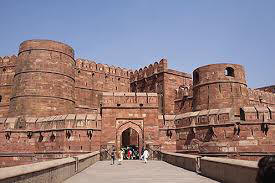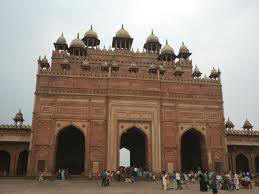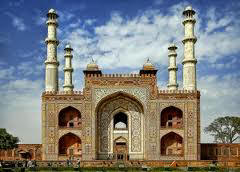|
One of the most beautiful structures
in the world, the Taj Mahal in Agra is something which dreams are
made of. This exquisite white and yellow marble structure stands
55 meters tall and is one of the most visited sites in the world.
Built in 1653 by the Mughal Emperor Shah Jahan in memory of his
late wife Mumtaz Mahal, this "elegy in marble" can also be called
the ultimate tribute to everlasting love.
A combined workforce of 20,000 people toiled hard for 22 years to
build this structure, which clearly surpasses everything else in
beauty and elegance. It is also amazing that the Taj Mahal in Agra
cost the exchequer 32 million rupees even at that time. Four
graceful minarets adorn each side of the Taj and the mausoleum
below is a magnificent work of art that is decorated with a number
of precious and semi precious stones. In fact, everything about
the Taj Mahal is purely magic be it the beautiful monument itself
or its geometrically shaped gardens. The Taj Mahal Agra has not
only enthralled people for centuries but has also inspired a
number of poets and writers to bring out the best of their
creative talents. Nobel laureate Rabindranath Tagore in one of his
famous quotes likened the Taj Mahal to a teardrop that glistened
"spotlessly bright on the cheek of time". What can be a better way
to describe this great saga of love?
Many people across the world nurse a secret desire to visit the
Taj Mahal at least once in their lifetime. Therefore it is not
surprising to see eternal romantics traveling half way across the
globe just to have a glimpse of the eternal beauty of the Taj. A
view of the Taj Mahal Agra on a foggy morning across the Yamuna
River is a very pretty sight. But nothing can surpass the mystic
and ethereal beauty of a glowing Taj Mahal on a moonlit night.
Nevertheless, at whichever point you visit this exquisite symbol
of love, the Taj Mahal's beauty is sure to cast a magic spell on
you forever.
Taj Mahal Location
Situated on the banks of River Yamuna the Taj Mahal in Ag ra
is like a dream rising out of the very depths of one's imagination
in all its beauty and splendor. Constructed on a raised sandstone
platform this magnificent structure is said to depict Emperor Shah
Jahan's vision of paradise. It may be noted that Shah Jahan was
actively involved in all the stages of the Taj Mahal's
construction. ra
is like a dream rising out of the very depths of one's imagination
in all its beauty and splendor. Constructed on a raised sandstone
platform this magnificent structure is said to depict Emperor Shah
Jahan's vision of paradise. It may be noted that Shah Jahan was
actively involved in all the stages of the Taj Mahal's
construction.
Many wonder as to why Shah Jahan chose to build the Taj at Agra
and not Delhi. The reason is that Agra was the Mughal capital
during that time, which made the Emperor decide in its favor.
Interestingly, soon after the construction of the Taj Mahal, Shah
Jahan shifted the capital to Delhi. Nevertheless, the site chosen
by him to raise his
dream structure was perfect in every sense. As you go to visit
this monument, you will be welcomed by beautiful gardens and
arched gateways lead you to the most beautiful symbol of love ever
built. Can there be anything more pleasing to the eye than the
sight of the Taj Mahal's marble façade reflected on the waters of
the Yamuna River flowing nearby?
The Taj has been constructed in such a strategic manner that it
has the same view from all four sides and is distinctly visible
from the Agra Fort. It may be mentioned here that the Agra fort is
the very place where Aurangzeb imprisoned Shah Jahan, who spent
his last days gazing at his beloved's tomb waiting for death to
unite him with her forever.
Taj Mahal History
The Taj Mahal's history dates back to 1631 when Mughal Emperor
Shah Jahan's beloved wife
Arjumand Bano passed away during childbirth. Mumtaz Mahal, as she
was affectionately known, was the Emperor's constant companion,
guide and the love of his life. They first met as teenagers, got
married in 1612 AD and thereafter were inseparable. Mumtaz Mahal
accompanied the Emperor to meetings, wars and campaigns and it was
during one such campaign that she passed away shortly after giving
birth to their 14th child. It is believed that the Mughal court
mourned the death of their beloved Empress for more than two
years. There were no celebrations or feasting on holidays for a
long time after Mumtaz Mahal passed away.
Before her death, Mumtaz Mahal expressed her wish that Shah Jahan
would "build a tomb in her memory such as the world had never seen
before." Thus stated the creation of one of the most beautiful
monument in the world, the Taj Mahal. A combined workforce of
20,000 people toiled hard for 22 years to build this structure,
which clearly surpasses everything else in beauty and elegance. It
is also amazing that the Taj Mahal in Agra cost the exchequer 32
million rupees even at that time. At the fag end of Shah Jahan's
career, he was imprisoned by his son Aurangzeb at the Agra Fort
and at that point of time the Taj Mahal was his only source of
comfort. He used to spend hours gazing at the Taj Mahal across the
Yamuna. After his death, he was laid to rest beside his beloved
wife and their two tombs are located in the basement of the Taj.
Its beauty notwithstanding, the Taj Mahal's history is also
something which continues to mesmerize people from all over the
world to date.
Agra Fort
Agra Fort is amo ng
the finest examples of the fusion architecture that has dominated
the Mogul period. The assimilation of these different styles has
given the buildings within the fort a distinctive look. To name a
few, for example, the Jahangir Palace built by Akbar is the most
magnificent blend of Persian and local style where as Divan-e-Aam
mixes subtleness of Turkish exteriors with the complex pattern of
Persian architecture. Other buildings within the premises of Agra
Fort either have a mixed style or conform predominantly to the
Islamic style. Some of the important buildings inside the Agra
Fort include Jahangir Mahal, Divan-e-Aam, Divan-e-Khash, Khas
Mahal, Anguri Bagh, Musamman Burj, Moti Masjid, Mina Masjid and
Shish Mahal among others. ng
the finest examples of the fusion architecture that has dominated
the Mogul period. The assimilation of these different styles has
given the buildings within the fort a distinctive look. To name a
few, for example, the Jahangir Palace built by Akbar is the most
magnificent blend of Persian and local style where as Divan-e-Aam
mixes subtleness of Turkish exteriors with the complex pattern of
Persian architecture. Other buildings within the premises of Agra
Fort either have a mixed style or conform predominantly to the
Islamic style. Some of the important buildings inside the Agra
Fort include Jahangir Mahal, Divan-e-Aam, Divan-e-Khash, Khas
Mahal, Anguri Bagh, Musamman Burj, Moti Masjid, Mina Masjid and
Shish Mahal among others.
Emperor Akbar the Great commissioned the Agra Fort that is also
sometimes called Red Fort of Agra. During the reign of emperor
Jahangir, the capital was briefly shifted to Lahore but Agra
became the seat of Mughal capital one again in the reign of Akbar.
Akbar became emperor in 1556 and when he consolidated himself
sufficiently, he started the construction of Agra Fort in the year
1665. The fort was completed in the year 1671 but minor
constructions and additions kept on happening till the reign of
Shah Jahan, his grandson. It is interesting to note that during
the reign of Akbar, the fort mainly served as a military garrison
but by the time of Shah Jahan it also started serving as a palace
and court.
Itmad-ud-daula
Itmad-ud-daula has a special place in the chronicles of both
history as well as architecture. This is precisely because Itmad
ud Daula is the very first tomb
in India that is entirely made out of Marble. This is actually a
mausoleum that overlooks the River Yamuna and is a tomb of Mir
Ghiyas Beg, a minister in the court of Shah Jahan.
Itmad-ud-daula is a pure white and elaborately carved tomb that
conforms to the Islamic style of architecture. The Indo-Islamic
architecture becomes prominent because of the fusion that this
tomb displays. While the use of arched entrances and octagonal
shaped towers signify the Persian influence, the absence of a dome
and the presence of a closed kiosk on top of this building and the
use of canopies talks about the possible Indian influence. From
out side, when you take a bird eye view, Itmad-ud-daula looks like
a jewel box set in a garden. This tranquil, small, garden located
on the banks of the Yamuna was to inspire the construction of the
Taj Mahal in the later years.
Fatehpur Sikri Agra
The heritage site of Fatehpur
 Sikri
is located 40 kilometers from Agra India. You can see this
magnificent city with its amazing monuments of red sandstone and
marble, built by the Mughal Emperor Akbar the Great, on tours to
Agra with Agra Hub. Sikri
is located 40 kilometers from Agra India. You can see this
magnificent city with its amazing monuments of red sandstone and
marble, built by the Mughal Emperor Akbar the Great, on tours to
Agra with Agra Hub.
According to legend, the Emperor Akbar, though he had many wives,
did not have an heir. He went on a pilgrimage to Sheikh Salim
Chisti, a Sufi saint who lived near Agra and sought his blessings.
Akbar was blessed with an heir, who he named Salim, after the
saint, in gratitude. (Salim later inherited the throne as the
Mughal Emperor Jahangir.)
The beautiful monuments at Fatehpur Sikri are a synthesis of
Islamic and Hindu architecture reflecting the religious tolerance
of Akbar. Akbar also founded a syncretic religion called Din-i-Illahi,
which inspired some of the buildings at Fatehpur Sikri. The city
of Fatehpur Sikri was built as a sign of the Emperor Akbar's
gratitude to Sheikh Salim Chisti. Work on the city started in 1571
and was completed 15 years later. Agra Hub takes you on tours to
Agra which include the historic destination of Fatehpur Sikri.
Akbar's Tomb at Sikandra
4 kilometers from Agra is Akbar's tomb a t
Sikandra which is an excellent example of assimilation of
different styles of architecture and it represents a significant
departure from the earlier Mughal buildings. The tomb carries the
characteristic flavor of the airy tiered pavilions of the Agra
Fort and Fatehpur Sikri. t
Sikandra which is an excellent example of assimilation of
different styles of architecture and it represents a significant
departure from the earlier Mughal buildings. The tomb carries the
characteristic flavor of the airy tiered pavilions of the Agra
Fort and Fatehpur Sikri.
Akbar started building the magnificent edifice at Sikandra, which
was later completed by his son Jahangir after his fathers death in
1605,. The tomb, as it stands today, is in a large walled garden
on the Delhi-Agra road. The tomb can be entered through an elegant
southern gateway, which leads into the huge enclosed garden. This
magnificent gateway is covered with floral and geometrical
arabesque decoration in white and colored marble is crowned with
four elegant minarets in white marble. |